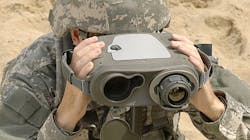Army taps DRS and BAE Systems to develop electro-optical one-man targeting systems
ABERDEEN PROVING GROUND, Md., 25 March 2013. The U.S. Army has chosen two companies for a one-year program to develop, prototype, and test a next-generation handheld electro-optical system to enable infantry soldiers, Marines, and joint terminal attack controllers to acquire, locate, identify, and designate targets quickly for air strikes or artillery attacks.
The Army Contracting Command at Aberdeen Proving Ground, Md., awarded contracts to the BAE Systems Electronic Systems segment in Nashua, N.H., and DRS RSTA Technologies Inc. in Dallas to develop prototypes for the Joint Effects Targeting Systems (JETS) Target Location Designation System (TLDS).
The JETS TLDS is a one-man targeting system to enable Army and Marine Corps forward observers and Air Force tactical air controllers to call for fire from indirect munitions like JDAM and Excaliber, as well as to call for close air support from all joint forces.
The two companies should be finished with this portion of the engineering and manufacturing (EMD) phase of JETS TLDS development in March 2014. DRS RSTA won a $15.6 million contract and BAE Systems won a $15.3 million contract.
The contracts were announced last Thursday. The Northrop Grumman Corp. Electronic Systems segment in Apopka, Fla., also has been involved in JETS TLDS development.
Among the goals of JETS is reducing friendly fire and collateral damage by helping soldiers differentiate between enemies, friendly forces, and civilians while working with satellite positioning and surveillance data.
Military forces need a lightweight handheld system for reconnaissance, surveillance, target acquisition, target engagement, and fires coordination for infantry forces, Army officials explain.
Current systems are far too heavy or lack necessary capability for accurate fire support during the day and at night, and do not work well with digital communications necessary to receive, transmit, store, display, plan, and coordinate targeting data.
DRS RSTA and BAE Systems will design and build JETS prototypes as part of the program's full-scale development phase, which should last for about 2 1/2 years. The companies will deliver between five and 20 prototype JETS systems.
JETS has two major subcomponents: the Target Location Designation System (TLDS) and the Target Effects Coordination System (TECS). The TLDS helps infantrymen acquire targets quickly.
The TECS, meanwhile, will send targeting data to digital fire-control networks that direct artillery, missiles, and aircraft attacks. The JETS user first will identify his location and target, and then sends that data to battle command systems for calls for fire.
For more information contact DRS RSTA online at www.drs.com/Products/RSTA, or BAE Systems Electronic Systems at www.baesystems.com.

